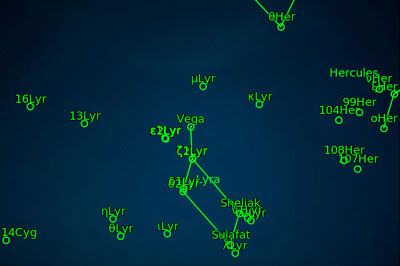A very faint Mercury (left above center) and a much brighter Venus (above the tree-line)
If you click for the larger image you can see ε Gem (Epsilon Geminorum), a star with an apparent magnitude of 3, above and to the left of Mercury.
If you click for the larger image you can see ε Gem (Epsilon Geminorum), a star with an apparent magnitude of 3, above and to the left of Mercury.
I am happy with the results.
After I got some shots of the triple (double?) conjunction I took some photos of the stars just to see what is possible with a 50mm (f/1.8) camera lens (aperture about 28mm) and a APS-sized DSLR on a simple tripod.
Just pointed the camera the brightest star, Vega, and took this photo with f=50mm (f/1.8) at 2.5 seconds exposure and ISO 400.
(Contains some image editing)
The constellation Lyra – cropped from the image above.
The bright star on top is Vega (one of the brightest stars in the sky), and on the left top one can see Epsilon Lyrae (with 208 arcseconds separation between ε1 and ε2). Notice how the Ring Nebula (Messier 57) is not even a smudge with this bad seeing and in this short exposure…
[Update]
I let astrometry.net do a "blind solver" for the full size image: FOV is 24.4 deg x 16.3 deg, and pixel scale is 22.6 arcsec/pixel.
[/Update]
[Update2]
I just realized that is close to Kepler's FOV!
[/Update2]
DSLR with 50mm f/1.8 photo lens pointed in the general direction of the Big Dipper (part of Ursa Major) – colors slightly changed.
I think I got the three stars γ, δ and ε from Ursa Major (or known as Gamma, Delta and Epsilon Ursae Majoris). Pointing a DSLR at the night skies with the built-in optical viewfinder is nearly impossible for me.
Definitely not clear skies… Notice the the streak left of centre – probably a satellite. Also at the right edge of the image one can see the colourful stars 4 Dra (red giant), Kap Dra (blue giant), 6 Dra (orange giant) and HD109822 (orange giant). At the lower right one can see 2 Dra (orange) and Lam Dra (red).
[Update]
Again astrometry.net: FOV is 24.6 deg x 16.4 deg, and pixel scale is 22.7 arcsec/pixel.
[/Update]
It is a nice step for me











No comments:
Post a Comment